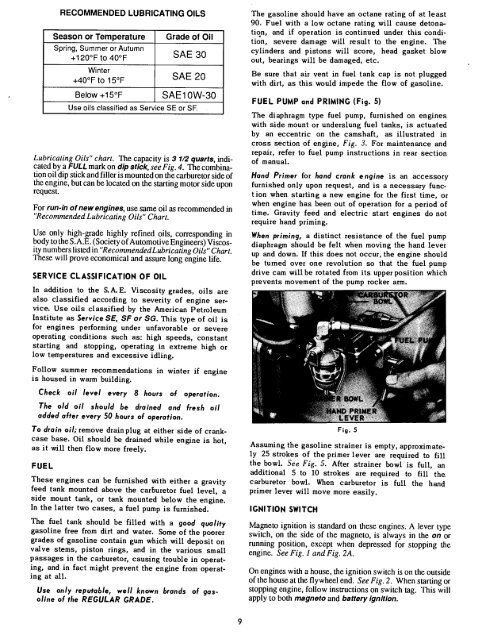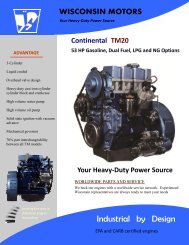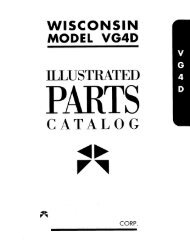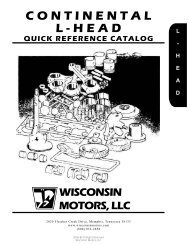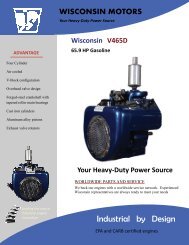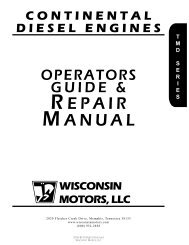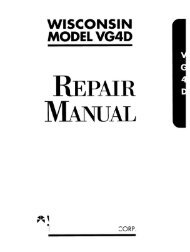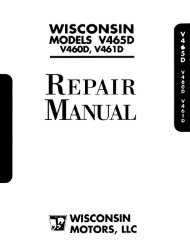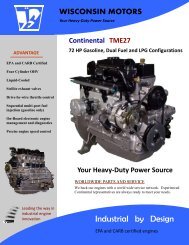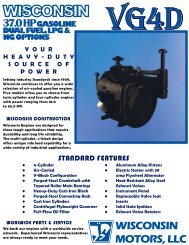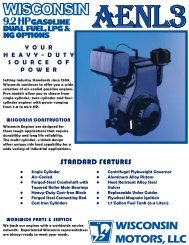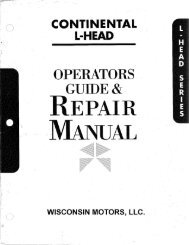W2-880 Tjd, Thd, Th - Repair - Wisconsin Motors
W2-880 Tjd, Thd, Th - Repair - Wisconsin Motors
W2-880 Tjd, Thd, Th - Repair - Wisconsin Motors
You also want an ePaper? Increase the reach of your titles
YUMPU automatically turns print PDFs into web optimized ePapers that Google loves.
RECOMMENDED LUBRICATING OILS<br />
Season or Temperature Grade of Oil<br />
Spring, Summer or Autumn<br />
+120°F to 40°F SAE 30<br />
Winter<br />
+40°F to 15°F SAE 20<br />
Below +15°F SAE 10W-30<br />
Use oils classified as Service SE or SF.<br />
Lubricating Oils" chart. <strong>Th</strong>e capacity is 3 1/2 quarts, indicated<br />
by a FULL mark on dip stick, see Fig. 4. <strong>Th</strong>e combination<br />
oil dip sdck and filler is mounted on the carburetor side of<br />
the engine, but can be located on the starting motor side upon<br />
request.<br />
For run-in of new engines, use same oil as recommended in<br />
"Recommended Lubricating Oils" Chart.<br />
Use only high-grade highly refined oils, corresponding in<br />
body to the S.A.E. (Society of Automotive Engineers) Viscosity<br />
numbers listed in "RecommendedLubricating Oils" Chart.<br />
<strong>Th</strong>ese will prove economical and assure long engine life.<br />
SERVICE CLASSIFICATION OF OIL<br />
In addition to the S.A.E. Viscosity grades, oils are<br />
also classified according to severity of engine service.<br />
Use oils classified by the American Petroleum<br />
Institute as Service SE, SF or SG. <strong>Th</strong>is type of oil is<br />
for engines performing under unfavorable or severe<br />
operating ,conditions such as: high speeds, constant<br />
starting and stopping, operating in extreme high or<br />
low temperatures and excessive idling.<br />
Follow summer recommendations in winter if engine<br />
is housed in warm building.<br />
Check oil level<br />
every 8 hours of operation,<br />
<strong>Th</strong>e old oil should be drained and hesh oil<br />
added after every 50 hours of operation.<br />
To drain oil; remove drain plug at either side of crankcase<br />
base. Oil should be drained while engine is hot,<br />
as it will then flow more freely.<br />
FUEL<br />
<strong>Th</strong>ese engines can be furnished with either a gravity<br />
feed tank mounted above the carburetor fuel level, a<br />
side mount tank, or tank mounted below the engine.<br />
In the latter two cases, a fuel pump is furnished.<br />
<strong>Th</strong>e fuel tank should be filled with a good quality<br />
gasoline free from dirt and water. Some of the poorer<br />
grades of gasoline contain gum which will deposit on<br />
valve stems, piston rings, and in the various small<br />
passages in the carburetor, causing trouble in operating,<br />
and in fact might prevent the engine from operating<br />
at all.<br />
Use only reputable, well known brands of gasoline<br />
of the REGULAR GRADE.<br />
<strong>Th</strong>e gasoline should have an octane rating of at least<br />
90. Fuel with a low octane rating will cause detonatic.n,<br />
and if operation is continued under this condition,<br />
severe damage will result to the engine. <strong>Th</strong>e<br />
cylinders and pistons will score, head gasket blow<br />
out, bearings will be damaged, etc.<br />
Be sure that air vent in fuel tank cap is not plugged<br />
with dirt, as this would impede the flow of gasoline.<br />
FUEL PUMP and PRIMING (Fig. 5)<br />
<strong>Th</strong>e diaphragm type fuel pump, furnished on engines<br />
with side mount or underslung fuel tanks, is actuated<br />
by an eccentric on the camshaft, as illustrated in<br />
cross section of engine, Fig. 3. For maintenance and<br />
repair, refer to fuel pump instructions in rear section<br />
of manual.<br />
Hand Primer for hand crank engine is an accessory<br />
furnished only upon request, and is a necessary function<br />
when starting a new engine for the first time, or<br />
when engine has been out of operation for a period of<br />
time. Gravity feed and electric start engines do not<br />
require hand priming.<br />
When priming, a distinct resistance of the fuel pump<br />
diaphragm should be felt when moving the hand lever<br />
up and down. If this does not occur, the engine should<br />
be turned over one revolution so that the fuel pump<br />
drive cam will be rotated from its upper position which<br />
prevents movement of the pump rocker arm.<br />
Fig. 5<br />
Assuming the gasoline strainer is empty, approximately<br />
25 strokes of the primer lever are required to fill<br />
the bowl. See Fig. 5. After strainer bowl is full, an<br />
additional 5 to 10 strokes are required to fill the<br />
carburetor bowl. When carburetor is full the hand<br />
primer lever will move more easily.<br />
IGNITION SWITCH<br />
Magneto ignition is standard on these engines. A lever type<br />
switch, on the side of the magneto, is always in the on or<br />
running position, except when depressed for stopping the<br />
engine. See Fig. 1 and Fig. 2A.<br />
On engines with a house, the ignition switch is on the outside<br />
of the house at the flywheel end. See Fig. 2. When starting or<br />
stopping engine, follow insta’uctions on switch tag. <strong>Th</strong>is will<br />
apply to both magneto and battery ignition.


